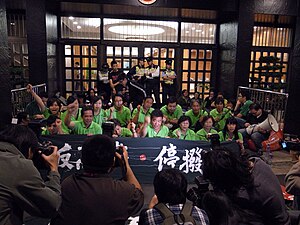Guangzhou–Hong Kong high-speed rail controversy

Villagers of the to-be-demolished Tsoi Yuen Chuen in front of HK Government offices in November 2009
|
|
| Date | 2009–2010 |
|---|---|
| Location | Legislative Council Building, Central Government Offices, Hong Kong |
| Participants | HK Govt., LegCo, Pan-democrat social activists, Hong Kong residents |
| Outcome | The bill passed in the LegCo. The XRL started constructions in 2010. |
The anti-Hong Kong Express Rail Link movement (Chinese: 反高鐵運動; literally: "anti-high-speed-rail movement") was a social movement and period of civil discontent in Hong Kong between mid-2009 and early 2010. Select groups of Hong Kong residents protested at the proposed Hong Kong section of the Guangzhou-Shenzhen-Hong Kong Express Rail Link (abbreviated XRL), a high-speed railway that would link Hong Kong with mainland China's growing high-speed rail network.
Segments of the general public and various interest groups opposed to certain aspects of the Hong Kong section of the project mobilised through petitions, marches, hunger-strikes, rallies to show their discontent at government insistence on pushing through the project. They cited cost, noise pollution, customs and border control complications, and existing rail links as main reasons for the opposition.
Pan-democracy legislators made the most of their limited opportunity within committee to question the project rationale within the Legislative Council of Hong Kong (LegCo), while civil groups kept vigil outside LegCo during the debate. The January protest has also been called the "siege of Legco" by local media. Ultimately, the movement was unsuccessful in impeding the government's plans to build the railway.
On 29 November 2009, a demonstration of more than 1,000 people protesting against the construction of the Express Rail link gained the attention of the local media when a group of 100 people engaged in a sit-in protest in front of the government headquarters in Central.
On 18 December 2009, the funding application was debated in the Finance Committee of the Legislative Council. A demonstration of an estimated 1,000 to 2,000 people was staged around the Legislative Council Building. The debate was put on hold and the funding was not yet finalised.
...
Wikipedia
